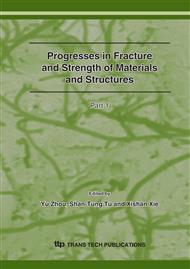p.34
p.38
p.42
p.46
p.50
p.54
p.58
p.62
p.66
The Grain Size and Porosity Dependent Constitutive Modeling for Nanocrystalline Ceramics with Small Plastic Deformation
Abstract:
In order to understand the grain size and porosity dependent mechanical behavior of porous, multi-phase nanocrystalline ceramics, each phase is treated as a mixture of grain interior and grain boundary, and pores are taken as a single phase. In conjunction with the secant-modulus approach and iso-strain assumption, Budiansky’s self-consistent method is extended to build a constitutive model for nanocrystalline ceramics with small plastic deformation. Based on the developed model, the predicted yield strength (σ0.2) values of porous, multi-phase nanocrystalline ceramics with different grain size and porosity are compared with experimental data in the literature, the comparison shows that the predictions are in good agreement with the published data. This suggests that the developed model is capable of describing the grain size and porosity dependent mechanical behaviors of nanocrystalline ceramics with small plastic deformation.
Info:
Periodical:
Pages:
50-53
Citation:
Online since:
September 2007
Authors:
Price:
Сopyright:
© 2007 Trans Tech Publications Ltd. All Rights Reserved
Share:
Citation:


